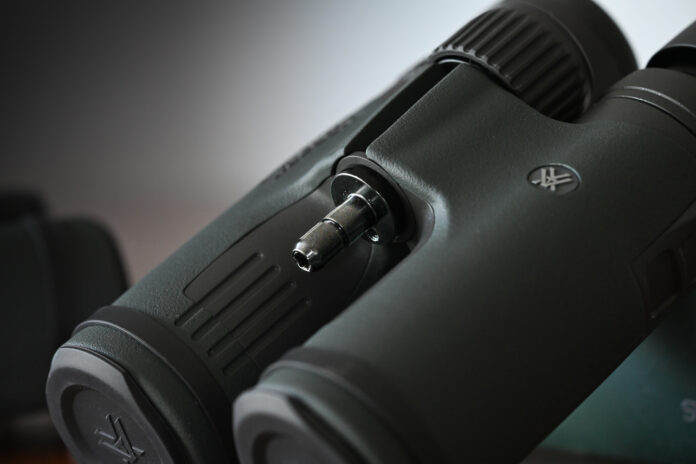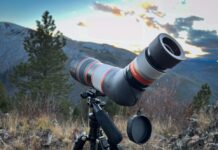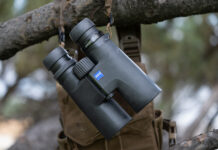Vortex Razor UHD 32mm
When it comes to the all-important hunting binocular, the “mid-range” offerings are the most competitive segment of the market. While the traditional “Euro” optics companies have all come out with models in the range, some of the most compelling options are the top offerings from US-based companies like Vortex, Maven, Tract, and others.

Vortex sized down with the new 32mm entries into their top-of-the-line Razor UHD series binoculars.
Value
Priced from $800 to $1600, binoculars in this class generally have pretty good optics and pretty good build quality. They provide a lot of value versus the top-of-the-line European binoculars that run $3,000 and up but are just a step below in performance. See them here.

The author tested both the 8×32 and 10X32 models of the Vortex Razor Ultra HD.
Vortex has long had great success in this segment, starting with the original Razor open bridge binocular and continuing through to the current Razor UHD 42mm, 50mm, and 56mm objective models.
The 42mm models have excellent performance and build quality for their price, but they are on the bulkier side with the 10X42 coming in at 7 inches tall and 32.4 ounces.
Vortex heard the call and expanded the Razor UHD line to two new models: the 8X32 and 10X32. I received samples of both models to test. I new I would need a comparison model, so I borrowed a Swarovski 10X30 CL. Given the 10X30 CL is comparable in both configuration (10×30,10×32) and street price ($1499 razor, $1449 CL). The Austrian 10X30 is well-regarded in optical performance.
Build Quality
The design cues for the 32mm Razor UHD models are taken directly from the bigger siblings. The binocular has quality rubber armoring accented by metal on the interior of the barrels. The bridge is 1/4-20 threaded and accepts standard tripod adapters. Diopter adjustment is accomplished through a metal ring on the right barrel. Four-position twist-out metal eyecups set the users eye position, but they are not removable.
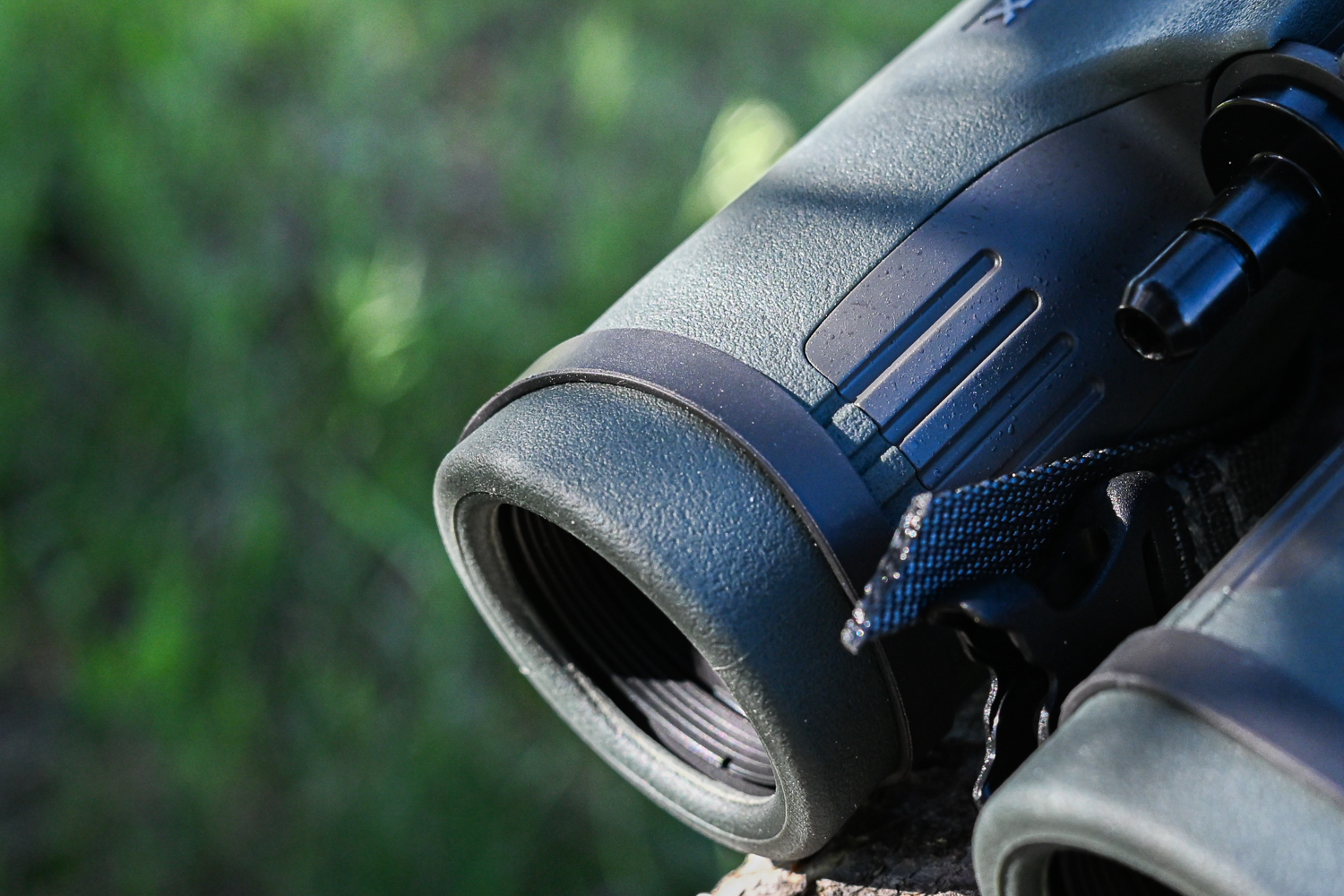
The Vortex UHDs are solid feeling with comfortable armor, and the smooth focus knob is within easy reach. The ergonomics feel a little utilitarian compared to the more svelte and compact feel of the CL, but the UHDs have a confidence-inspiring durable feel.
The size got me thinking. Sure, the 10X32 and 8X32 Razor UHDs are significantly more compact and lighter than the full size 42mm model Razor UHDs, but what about versus smaller full-size binoculars from competitors?
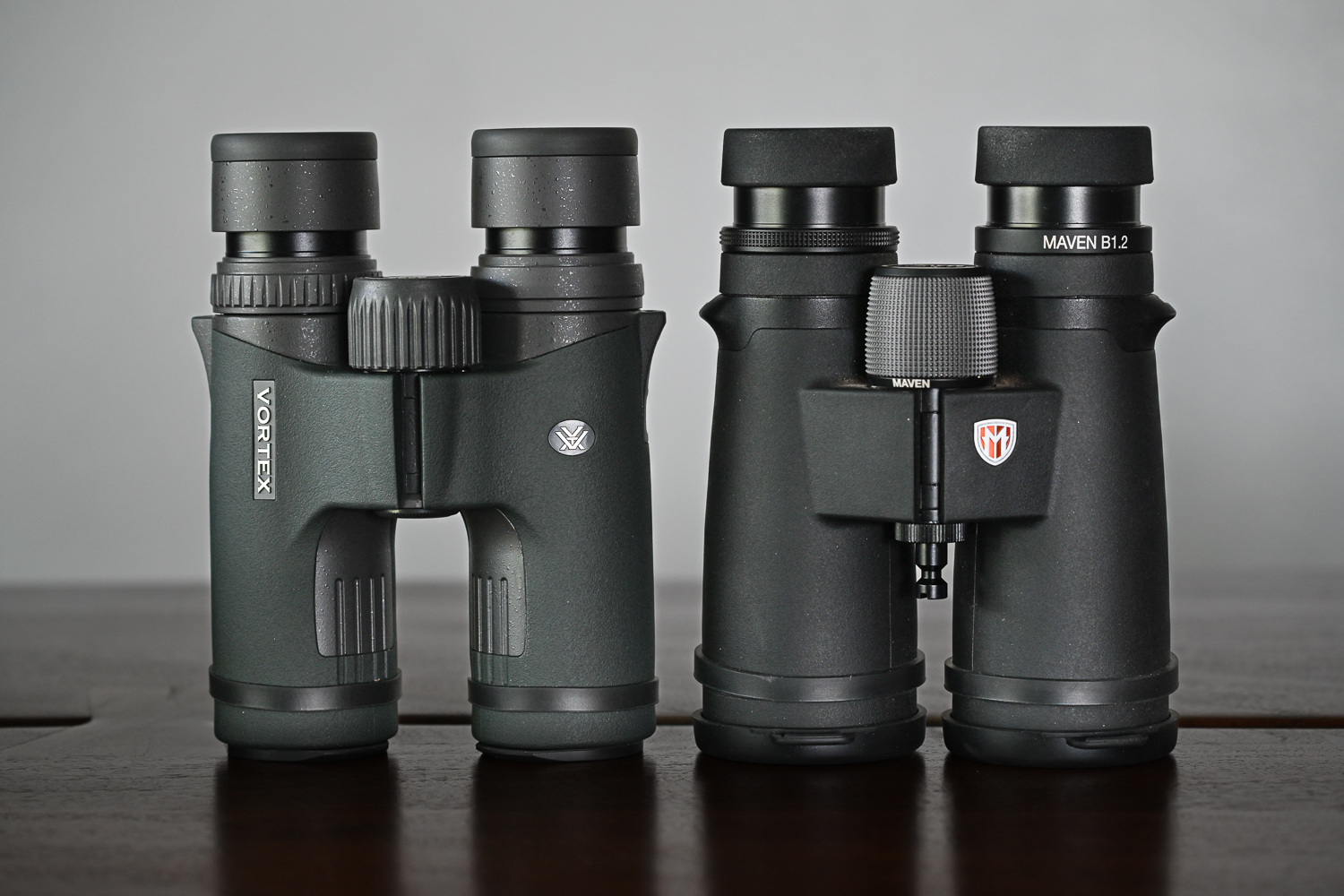
I compared the Razor UHDs to one of the more compact full-size 10X42s, the Maven B1.2. The Razors were a little narrower but the same height. The difference was still notable on the scale, however, with the Razor UHD 32 checking in at 1 lb. 5.8 oz. compared to the B1.2’s 1 lb. 10.9 ounces. A 5-ounce weight savings is substantial.
The Swarovski CL seems downright tiny next the Razor UHD. It is shorter, narrower, and well … smaller. While the Razor UHD saves 5 ounces on the Maven B1.2, the CL saves another 4 ounces on the Razor UHD weighing in at a diminutive 1 lb. 1.7 oz.
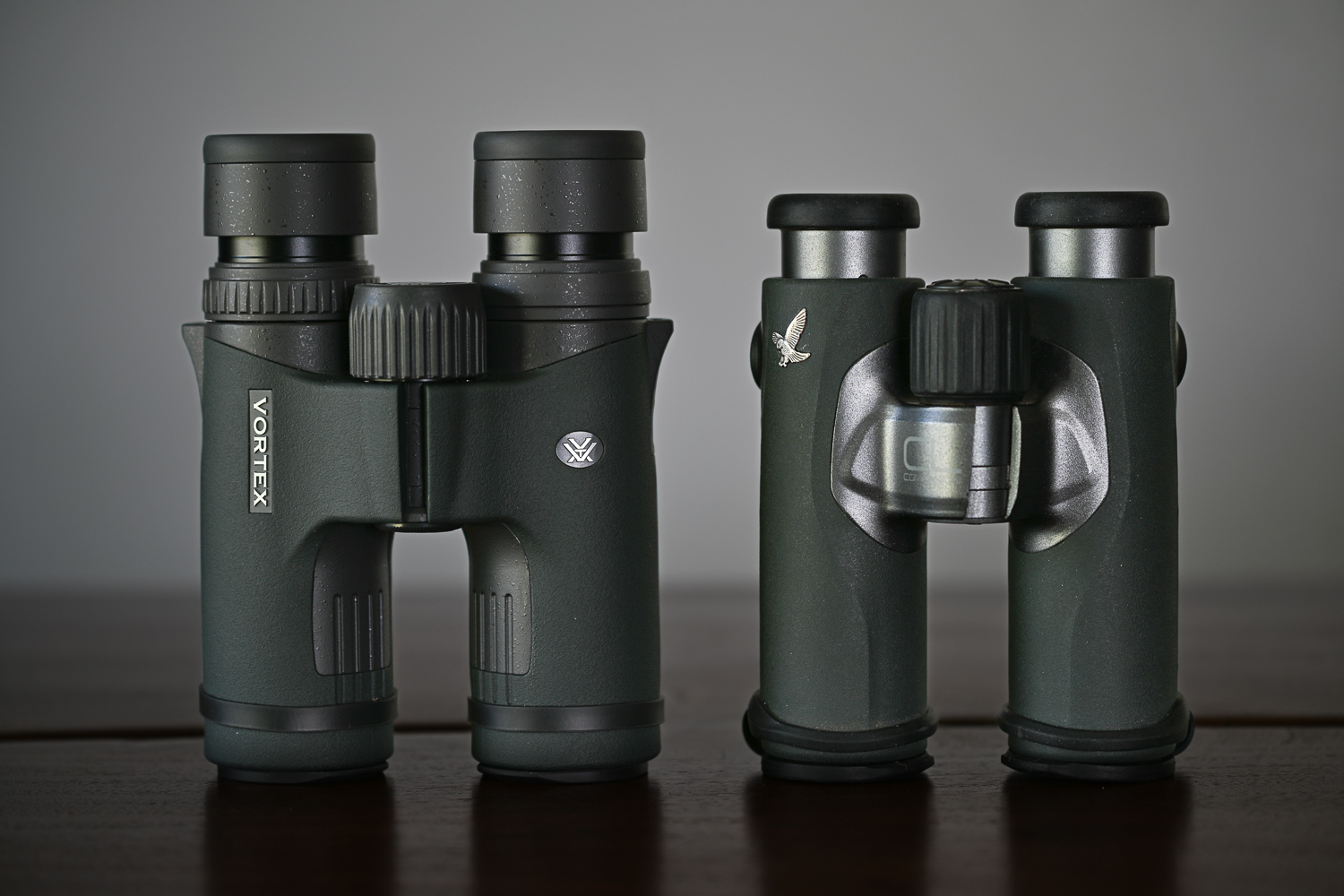
The wide eyecups are similar to the bigger Razor UHDs and have a thin rubber ring at the user’s face. This worked well with my face structure, but some may find a narrower and/or thicker ring found on competitors more comfortable. I found the eyecups fit me best, fully extended, and accommodated glasses easily when collapsed. The fully extended setting held fast, but the middle settings could collapse easily. Unfortunately, the eyecups are not removable for cleaning. Focus is achieved by the reasonably smooth rubberized central focussing wheel.
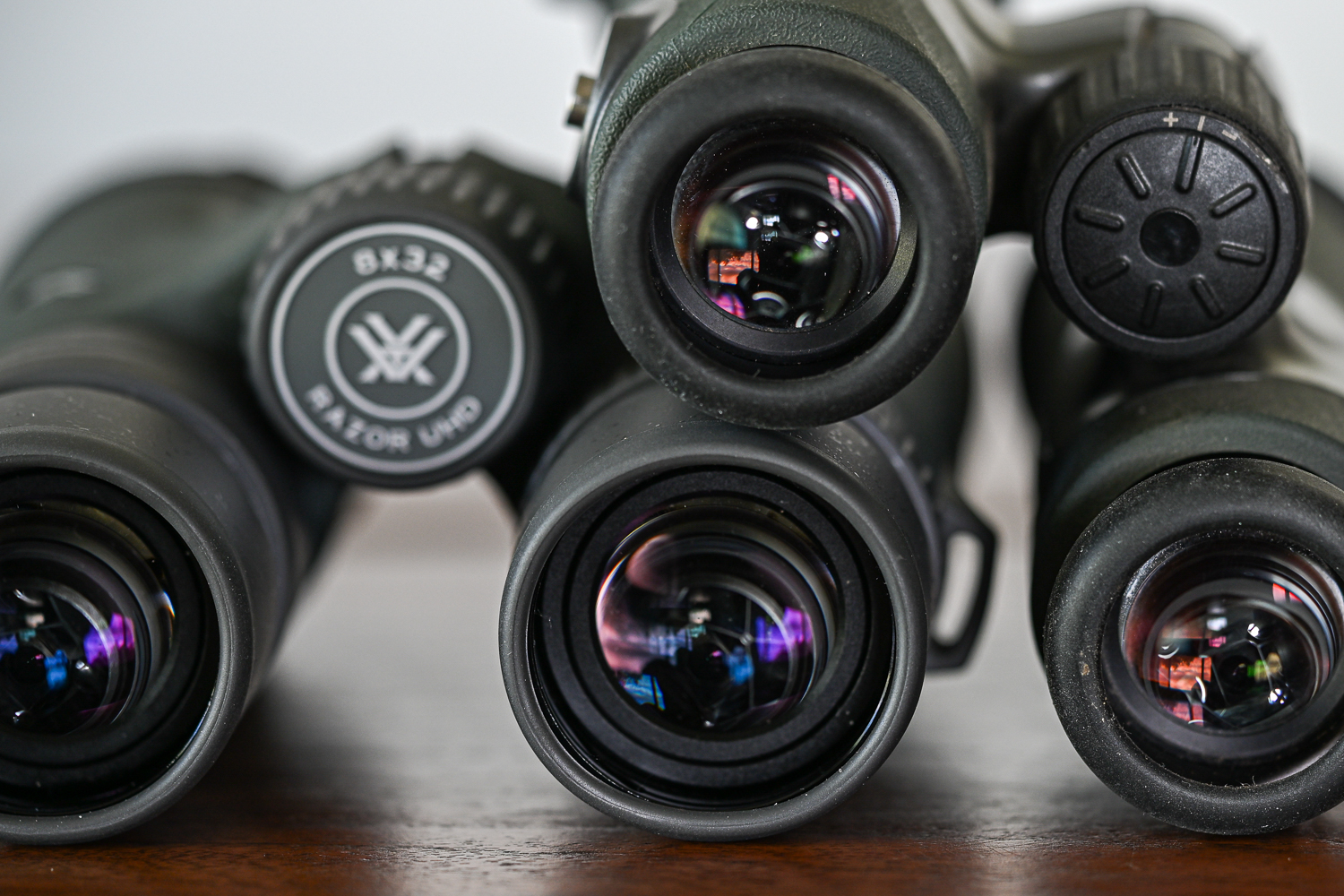
Optical Performance
The Swarovski CL 10X30 has a good reputation for optical performance. While it doesn’t reach the lofty heights of the top-of-the-line NL series binoculars, the CL optics remind me of the original Swarovski EL 32mm models, which I have used happily over the years. The CL is certainly a quality, high-performance binocular.
Resolution
Both the 8×32 and 10X32 models are tack sharp in the center of the field. In fact, I could resolve the same element on the resolution chart with the 8×32 Razor UHD as I could with the 10X30 Swarovski CL. The 10×32 Razor UHD took it a step further and resolved the next smaller element on the chart.
There is some fall-off in resolution towards the edge of the field in both models, but the edge of the field is still useably sharp.
Distortion
Both the 8×32 and 10X32 showed minor pincushion distortion. I suspect this was a design intent as a way to mitigate the rolling ball effect of some low distortion binoculars. The Swarovski 10X30 CL showed noticeably less distortion, but the difference was only noticed when glassing straight lines.
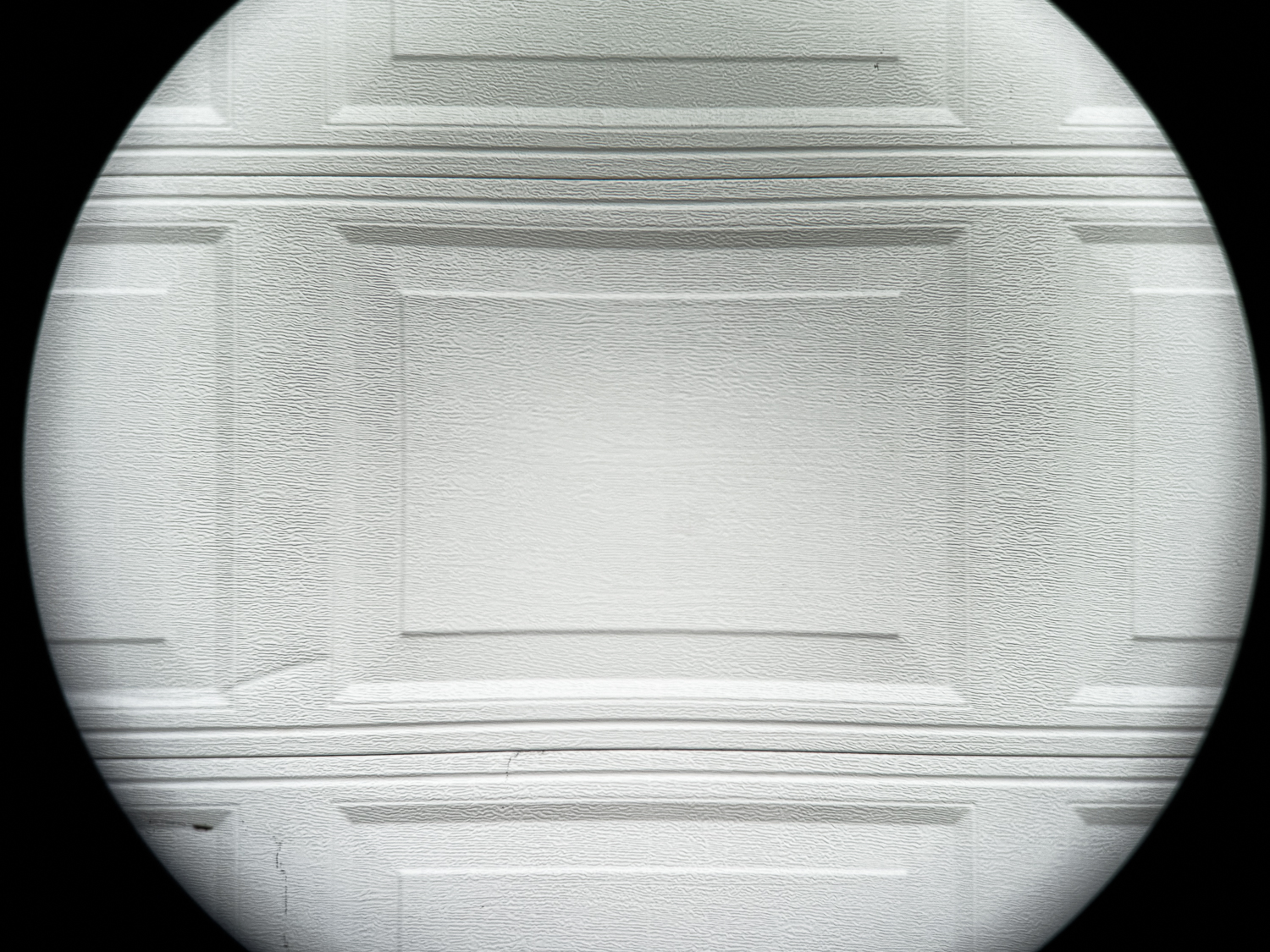
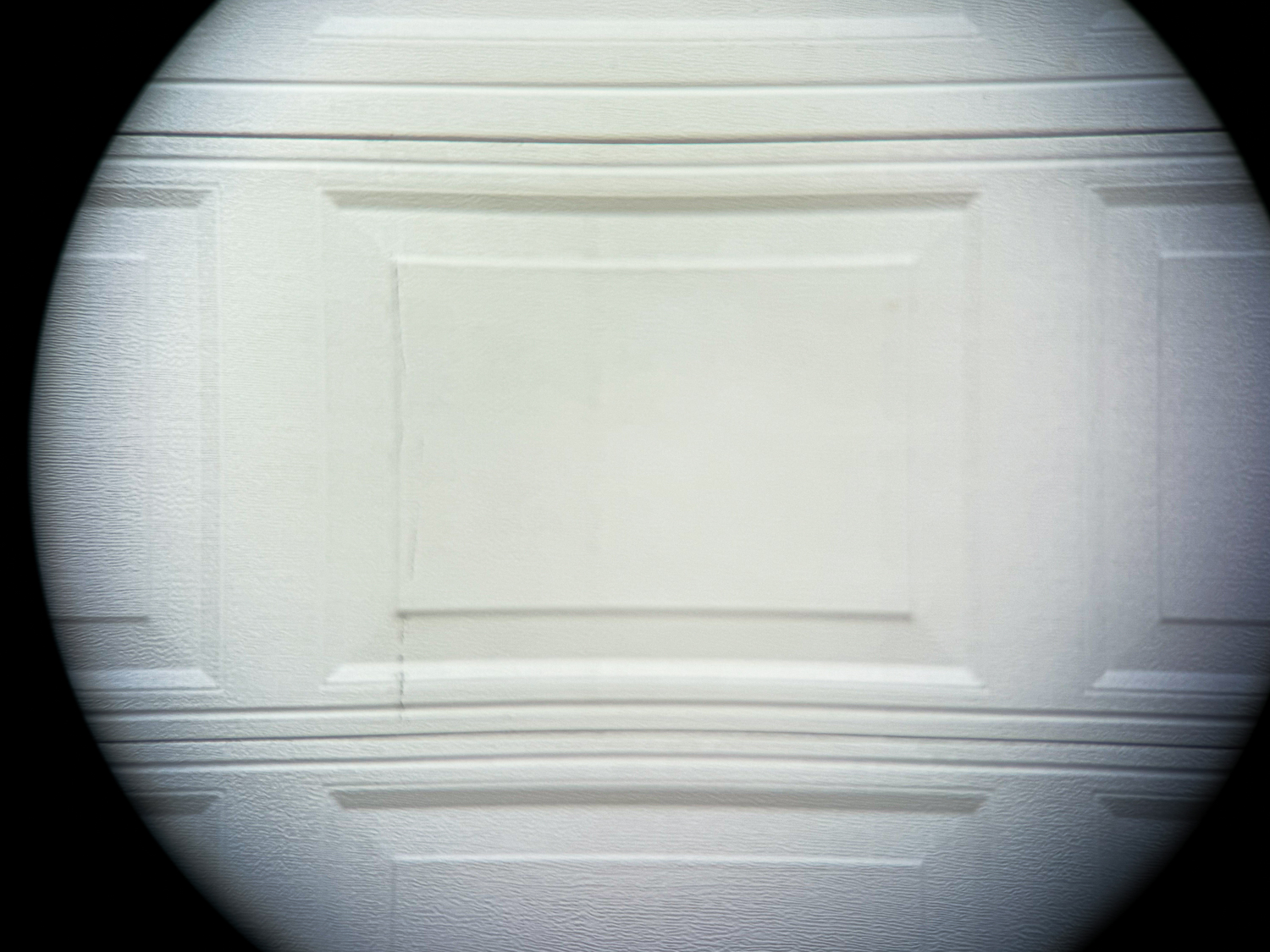
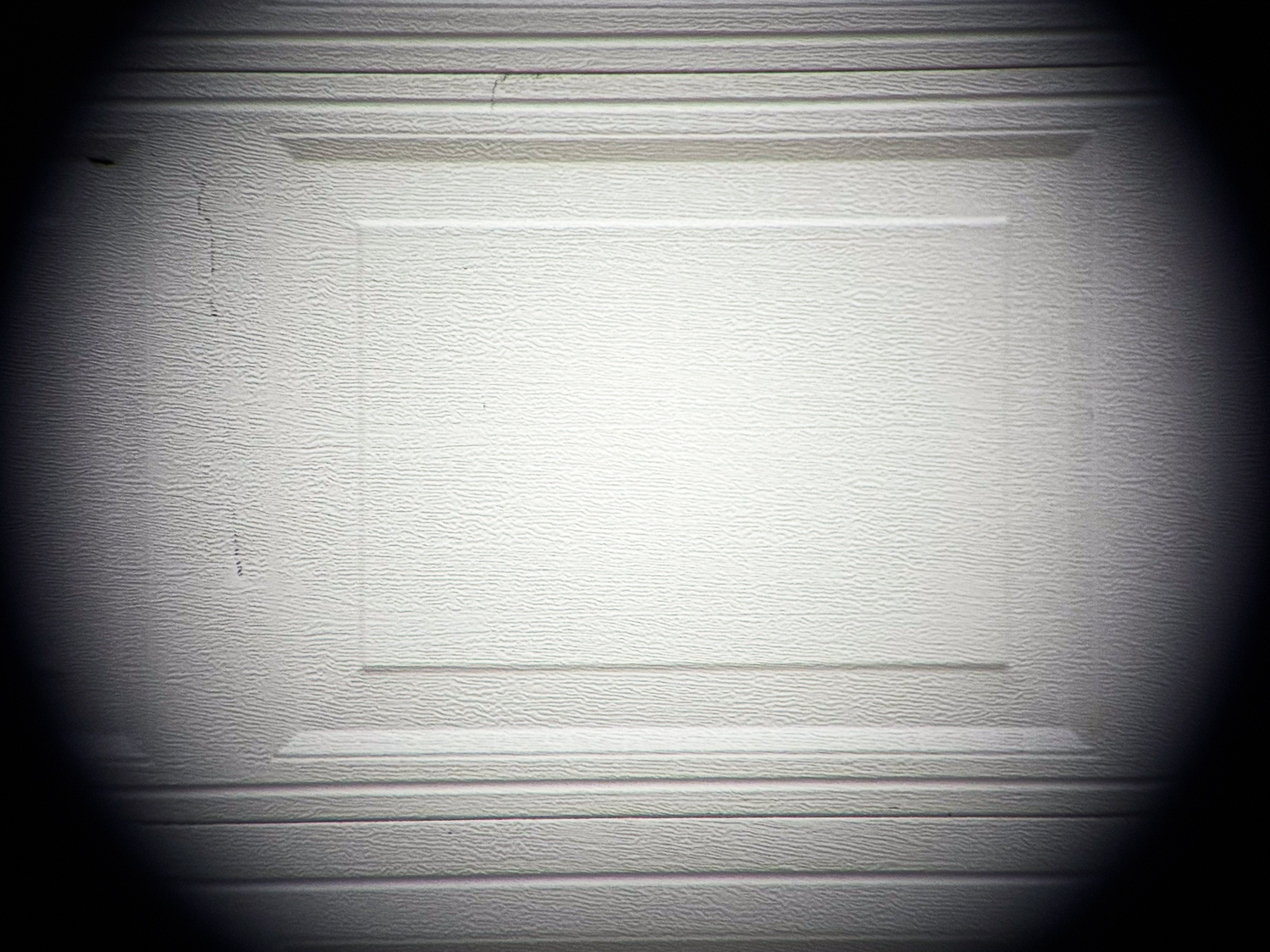
Field Curvature
Like many ultra-wide-angle binoculars, the two Vortex models had clear signs of curvature of field when observing objects at closer distances. That is, when objects in the center are sharply focused, objects at the edge of the field are not sharply focused, and vice versa. However, I would happily deal with this compromise to have the immense fields of view the Razor UHD provides.
The Swarovski CL showed similar field curvature at closer distances.
Note that Field curvature at longer distances is not really noticeable due to the increased depth of field when focussed at a distance.
Chromatic Aberration
Again, the 8×32 and 10×32 Razor HDs had excellent centerfield performance with no color fringing, even on the resolution target. As you left the center of the field, fringing started to show up in very low amounts until the edge, where it was just visible. This is a very good level of correction for binoculars of this type and with this wide of a field.
The Swarovski CL 10X30 showed more color fringing, even in the center of the field. When it comes to Chromatic Aberration, the Razor UHDs are better corrected.
Contrast
Both models of the Razor UHD 32mm provide a similar, high-contrast image, where colors are easily differentiated, and detail is readily pulled from shadowy areas. The levels of contrast were similar to those shown by the Swarovski CL.
Field of View
The Razor UHD 32mm models are wonderfully wide. The expansive 388 ft. / 1000 yards of the 10×32 Razor UHD is 64 feet wider than the 324 ft. / 1000 yards of the 10X30 CL and just 8 feet short of the whopping 396 ft. / 1000 yards of Swarovski’s flagship 10X32 NL.
The 8×32 model bumps that up to a gigantic 472 ft. / 1000 yards for a truly mega-wide viewing experience.
When switching between the binoculars, the Swarovski felt pretty narrow in comparison.
Low Light Performance

The 8×32 and 10X32 Razor UHDs have good low-light performance for their class. The 10×32 allowed for better illumination at the same evening times as the 10×30 CL. The 10X32 UHD kept a couple of minutes of useable light past the 10X30 CL. Physics wins again, however, and the 8×32 went furthest into the dark due to its larger exit pupil, at the expense of magnification, of course.
Most hunters understand the limitations of 32mm class binoculars in low light. Comparable larger objective binoculars of the same magnification will give better low-light performance. The Razor UHD 32mms did well for its configuration, but the larger objective siblings will do a little better here.
In-the-Field Performance

I used both versions of the Razor UHD 32mm for general glassing and range sessions. I even took the 8×32 model on a long (45-mile) backpacking and scouting trip in the Wilderness of Idaho.
What I found was that the binoculars provide an easy, high-performance binocular glassing experience. The expansive fields of view make covering large amounts of country easier. What I really noticed is that the Razor UHDs don’t feel like a 32mm binocular. They feel like a full sized binocular, but lighter. I actually preferred the full-size “feel” when glassing. Still, the Razor UHD 32mm binoculars join their 42mm siblings in being a bit bulky for their class.
One full-size feature I really appreciated was the ability to easily mount the Razor UHD on a tripod with the convenient 1/4-20 exit in the bridge. I often use my binoculars tripod mounted and find easy tripod adapting essential.
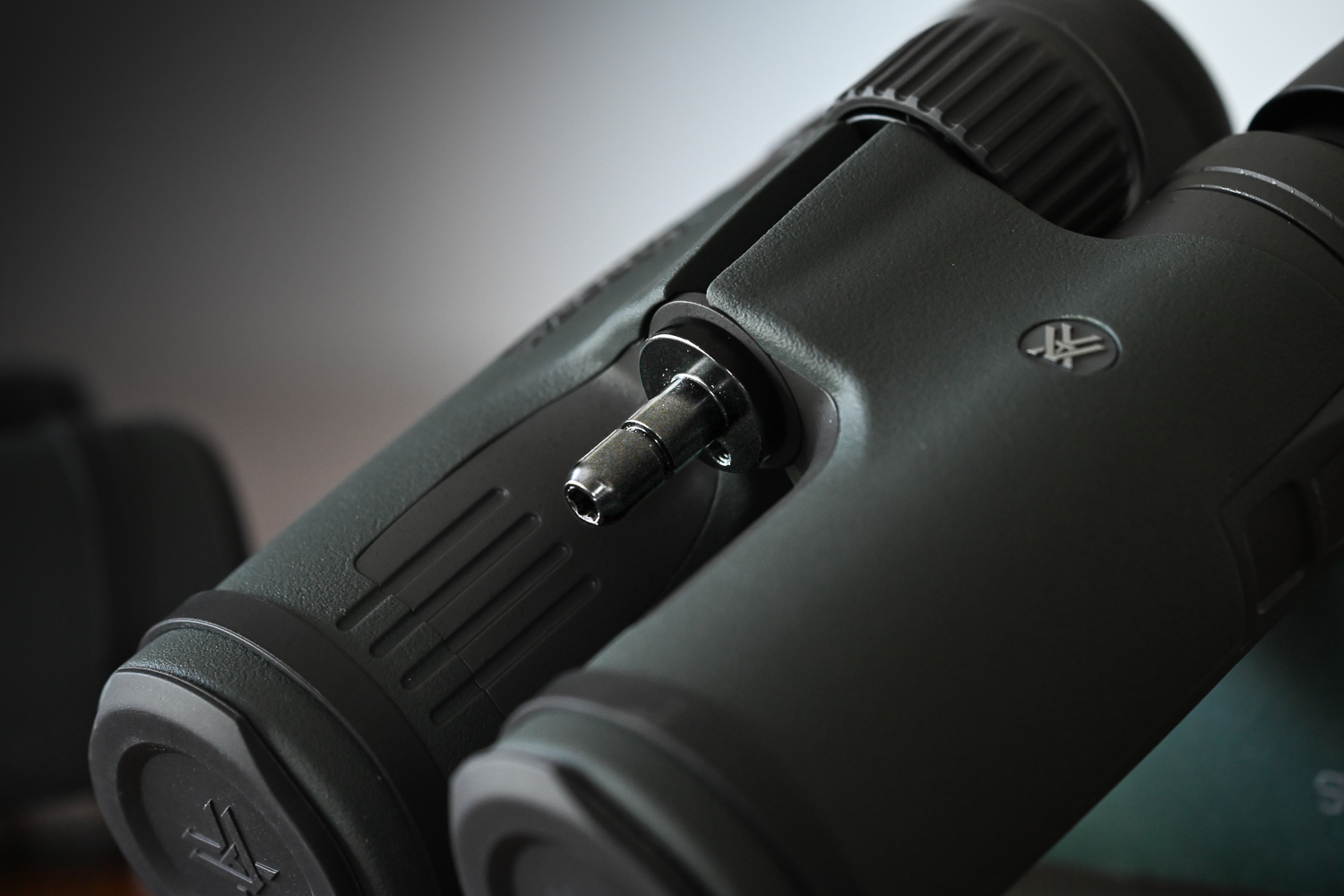
Glasspack Pro Case
Each Razor UHD comes with a fully featured “Glasspack Pro” binocular case/harness. This isn’t the run-of-the-mill included binocular case. The Glasspack Pro is a front-opening style case perfectly sized to the binocular. It is made of a quiet, soft material. The harness straps are an open mesh design that can be attached and removed from the case according to the hunter’s preference. There are two slot packets against the chest and a front-facing zippered pocket.

It was pretty surprising just how high-end the included harness is. It even came with a matching rangefinder case.

I found the Glasspack Pro case to be a BIG step up over other included cases. The harness worked as intended, even if it was hard to get my phone in and out of the slot pocket. It carries weight well, and allows for silent retrieval of the binocular. While I won’t be giving up my trusty FHF bino harness, there is no doubt many hunters will find they don’t need to spend any money on an additional harness with the Glasspack Pro included.

Conclusion
Overall, Vortex did well with its expansion of the popular Razor UHD line of binoculars with 32mm models. The 8×32 and 10X32 Razor UHD combine solid build quality with high-end optical performance. Performance that provides real advantages even over tough competition like the Swarovski CL. Both models provide excellent sharpness, good low-light performance, ultra-wide fields of view, and good aberration control. There are some minor compromises on distortion and edge performance to accommodate that expansive field of view, but I will take it. Don’t forget that there is no need to shop for a quality harness, as one comes in the box.
The 8X32 and 10X32 Vortex Razor HDs are great options for any hunter looking for full-size performance in a lighter, more compact form factor. Available here.
Comment or ask Matt questions here.
Read more optics reviews.
Vortex is a Rokslide advertiser.














